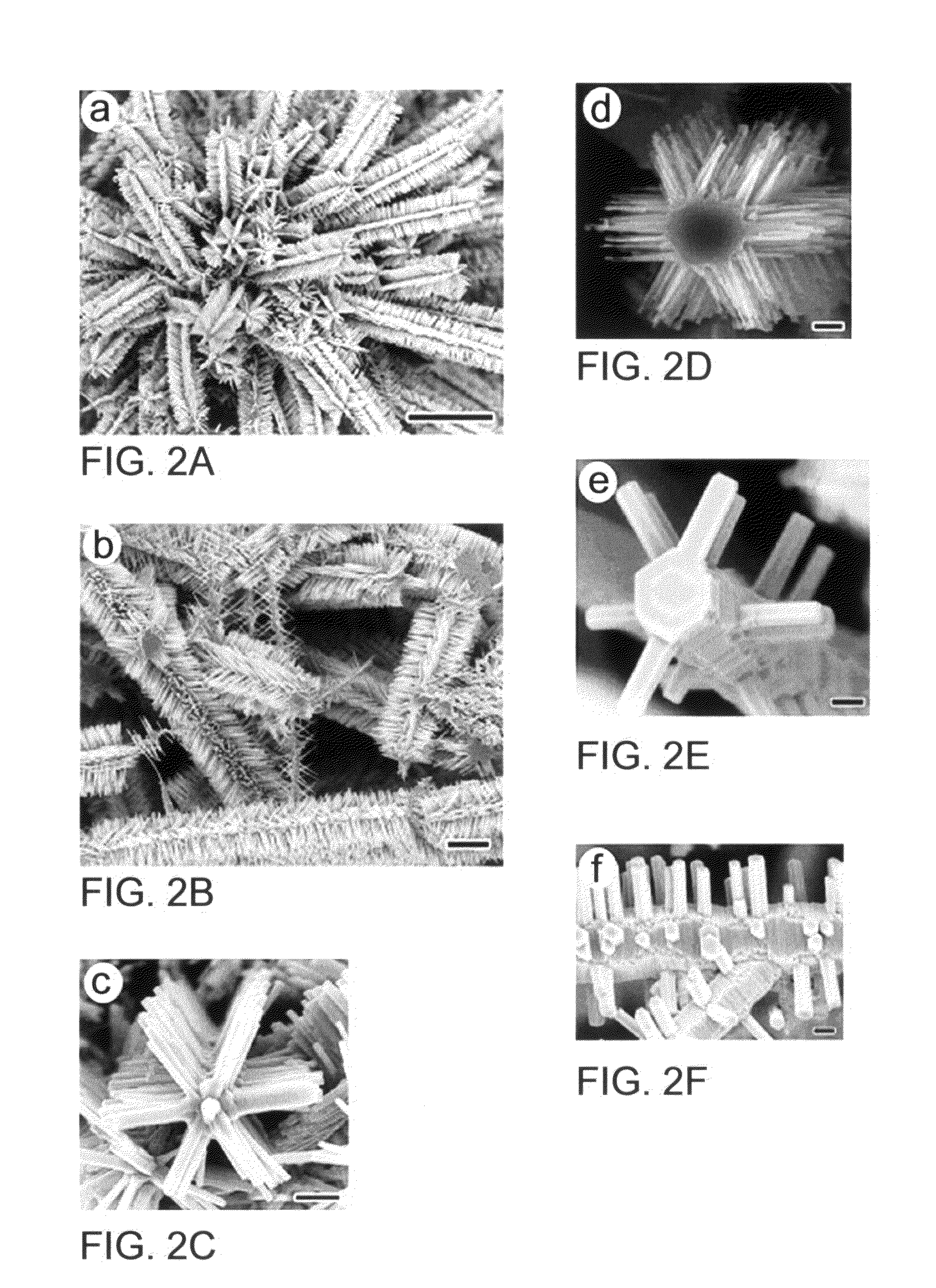Metal oxide nanostructures with hierarchical morphology
a metal oxide and hierarchical morphology technology, applied in the direction of oxygen/ozone/oxide/hydroxide, natural mineral layered products, yarn, etc., can solve the problems of insufficient free-standing material production, limited practical realization of materials, and insufficient yield of prior art methods, etc., to achieve stable field emission electron source
- Summary
- Abstract
- Description
- Claims
- Application Information
AI Technical Summary
Benefits of technology
Problems solved by technology
Method used
Image
Examples
example 1
Synthesis of ZnO Hierarchical Nanostructures
[0154]A mixture of ZnO and graphite powders are used as the source and put into the sealed end of a small quartz tube. The source is placed at the open end of the quartz tube and covered with graphite foil for the ZnO nanostructure growth. Then the whole assembly is pushed into a ceramic tube of a tube furnace pumped by a rotary pump. The vacuum in the ceramic tube is maintained at about 0.5 to 2.5 Torr. The source temperature was elevated to about 950° C.-1050° C. and maintained for about 15-30 min at pressure of 0.5-1.5 Torr air. After cooling, ZnO nanostructures are observed either on the substrate or graphite cover foils. The samples are analyzed using a JEOL JSM-6340F scanning electron microscope (SEM), a Bruker Analytical X-ray System, and a JEOL 2010 transmission electron microscope (TEM).
example 2
Synthesis of ZnO, In2O3 Hierarchical Nanostructures
[0155]ZnO, In2O3 and graphite powders are mixed thoroughly to form a metal oxide source powder. The reactant powder is placed at the sealed end of a one-end sealed quartz tube A graphite foil sample collector is placed at the open end of the quartz tube for collecting the ZnO hierarchical nanostructure samples. The assembly comprising the reactant powder, quartz tube and sample collector, is pushed into a ceramic tube of a tube furnace pumped by a rotary pump as a vacuum source. The vacuum in the ceramic tube is maintained at about 0.5 to about 2.5 Torr. The temperature of the furnace, at the sealed end of the quartz tube containing the metal oxide source powder, is raised to and maintained at about 950° C. to about 1000° C. The temperature of the furnace, at the open end of the quartz tube having the graphite foil sample collector, is raised to and maintained at about 820° C. to about 870° C. The temperature is maintained for about...
example 3
Synthesis of ZnO Nanobridges
[0156]The same process as described in Example 1 by varying the parameters. ZnO nanobridge structure formation is favored at low In2O3 ratio in the source with a 2.0 Torr air pressure and furnace temperature at 1000° C. ZnO Nanobridges can be formed using the process as described in J. Y Lao et al., Nanoletters, volume 3, pages 235-238, (2003), the contents of which is hereby incorporated herein by reference in its entirety.
[0157]ZnO, In2O3 and graphite powders are mixed thoroughly to form a metal oxide source powder. The metal oxide source powder comprises a low In2O3 / ZnO ratio. The reactant powder is placed at the sealed end of a one-end sealed quartz tube A graphite foil sample collector is placed at the open end of the quartz tube for collecting the ZnO hierarchical nanostructure samples. The assembly comprising the reactant powder, quartz tube and sample collector, is pushed into a ceramic tube of a tube furnace pumped by a rotary pump as a vacuum so...
PUM
| Property | Measurement | Unit |
|---|---|---|
| length | aaaaa | aaaaa |
| length | aaaaa | aaaaa |
| diameter | aaaaa | aaaaa |
Abstract
Description
Claims
Application Information
 Login to View More
Login to View More - R&D
- Intellectual Property
- Life Sciences
- Materials
- Tech Scout
- Unparalleled Data Quality
- Higher Quality Content
- 60% Fewer Hallucinations
Browse by: Latest US Patents, China's latest patents, Technical Efficacy Thesaurus, Application Domain, Technology Topic, Popular Technical Reports.
© 2025 PatSnap. All rights reserved.Legal|Privacy policy|Modern Slavery Act Transparency Statement|Sitemap|About US| Contact US: help@patsnap.com



